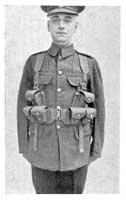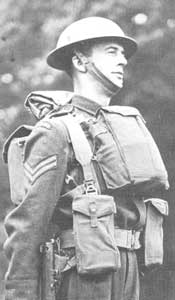Web Infantry Equipment, Pattern 1937
Web Equipment for the Age of Mechanised War

 Conducted under the aegis of the Braithwaite Committee, the web equipment trials of 1932-34 resulted in the selection of the Number 3 Pattern (shown right). The War Office then deferred putting it into service, pending the “…forthcoming introduction of automatic firing rifles…”, according to Lethern. Previous writers have stated this to be the Bren Gun, completely ignoring two facts: Lethern says “rifle”, not “L.M.G.” and trials were at that time being conducted on the .276-in. Pedersen Self-Loading Rifle, manufactured under licence by Vickers. In the event, this weapon was not adopted, but separate trials – for a Lewis Gun replacement – resulted in the selection of the immortal Bren Gun in 1936. Being fed by a 30 round box magazine, the War Office now required a re-think on the part of the Mills Equipment Company, since the No. 3 Equipment had catered only for charger-loaded rifle ammunition.
Conducted under the aegis of the Braithwaite Committee, the web equipment trials of 1932-34 resulted in the selection of the Number 3 Pattern (shown right). The War Office then deferred putting it into service, pending the “…forthcoming introduction of automatic firing rifles…”, according to Lethern. Previous writers have stated this to be the Bren Gun, completely ignoring two facts: Lethern says “rifle”, not “L.M.G.” and trials were at that time being conducted on the .276-in. Pedersen Self-Loading Rifle, manufactured under licence by Vickers. In the event, this weapon was not adopted, but separate trials – for a Lewis Gun replacement – resulted in the selection of the immortal Bren Gun in 1936. Being fed by a 30 round box magazine, the War Office now required a re-think on the part of the Mills Equipment Company, since the No. 3 Equipment had catered only for charger-loaded rifle ammunition.
New tactics had first to be evolved, the outcome of which was each infantry section of eight men would have one Bren Gun. Each man would carry a proportion of the Bren magazines, plus rifle ammunition in Bandoliers, cotton, 50 rounds. Mills then designed a novel pouch which, for the very first time, did not include either “ammunition”, or “cartridge” in its nomenclature. The Pouch, basic, had arrived, which would set the standard for ammunition carriage thereafter.
 In the tried and tested Mills way, the rest of Pattern 1937 W.E. drew on many earlier designs. The Pattern is often referred to as a “new” design, but many of its components had been designed before the Great War. Even the Basic pouch, which rather defined the “look” of Patt. ’37, was an earlier design, just made larger. Trials of the new Pattern were conducted in 1937, though they must also have been able to draw on some results from the Braithwaite Committee Trials. It was realised that “…personnel armed with rifles, other than infantry…” required an ammunition pouch, so the 20 round Carrier, cartridge, was added. The trials eventually settled on the Pouch, basic, and one other. This was a larger version of the Basic pouch, the Pouches, utility, fitted out differently, but which could cope with magazines for either the Bren Gun, or the .55-in. Boys Anti-Tank rifle, or bombs for the 2-in. Mortar. In June 1938, an announcement was made that the Pattern would be issued to Regular Army infantry units.
In the tried and tested Mills way, the rest of Pattern 1937 W.E. drew on many earlier designs. The Pattern is often referred to as a “new” design, but many of its components had been designed before the Great War. Even the Basic pouch, which rather defined the “look” of Patt. ’37, was an earlier design, just made larger. Trials of the new Pattern were conducted in 1937, though they must also have been able to draw on some results from the Braithwaite Committee Trials. It was realised that “…personnel armed with rifles, other than infantry…” required an ammunition pouch, so the 20 round Carrier, cartridge, was added. The trials eventually settled on the Pouch, basic, and one other. This was a larger version of the Basic pouch, the Pouches, utility, fitted out differently, but which could cope with magazines for either the Bren Gun, or the .55-in. Boys Anti-Tank rifle, or bombs for the 2-in. Mortar. In June 1938, an announcement was made that the Pattern would be issued to Regular Army infantry units.
The Pattern continued in service into the 1980s, disappearing from Section CN of the Catalogue of Ordnance Stores and Ammunition (C.O.S.A.) between the successive editions of 1985 and 1991. Patt. ’08 had been in service from 1908 to 1946 - 38 years, but Patt. ’37 lasted from 1938 to 1985 – 47 years, possibly even celebrating its Golden Jubilee, which it certainly did in India! Sadly, this also meant that Patt. ’37 survived its design company, Mills having been taken-over by RFD-GQ, who in turn disappeared in the various moves made by so-called venture capitalists. Thinks – were pirates venture capitalists…?